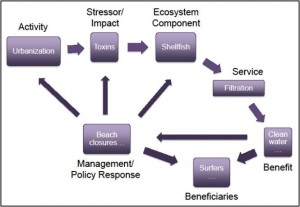
PacMARA, the University of British Columbia, and the Packard Foundation recently organized a workshop to better structure ecosystem-based knowledge using pathways of effects. The main goal of the workshop was to improve ecosystem-based management (EBM) practice, research, and communication through design of a standardised structure and method for presenting EBM components, the linkages between them, and their relevance to management.

By bringing together both the developers and consumers of EBM information, we have begun the process of standardizing the definitions of the fundamental EBM components (e.g., human activities, ecosystem components, ecosystem services, beneficiaries) and their linkages (e.g., stressors, impacts, benefits). We will also begin to provide a repository for EBM information organised according to the pathways of effects model (see figure for an example).
Representing EBM knowledge using a consistent structure will help identify knowledge gaps, inspire targeted research on pathways of effects, and help develop and guide EBM efforts. We believe that practitioners will be able to see clear linkages between research and monitoring, and the indicators necessary for decision-making. Locating this effort in an academic setting will entrench impartiality, respect for data and intellectual property, and equitable access to outputs.
Ultimately, we hope to produce a consistent, comprehensive, and intuitive structure to represent ecosystem components, services, and benefits, human uses, and the linkages between them. This web-based repository (“EBMBase”) will facilitate the sharing of existing and emerging EBM applications focused on risks, impacts, and the processes by which ecosystems provide benefits to people.